The energy system of the country — a brief description, characteristics of work in different situations
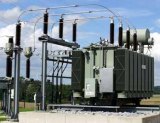 The country's energy system is a combination of several elements - power plants, step-up and step-down distribution substations, electric and heat networks.
The country's energy system is a combination of several elements - power plants, step-up and step-down distribution substations, electric and heat networks.
Power plants produce electrical and thermal (for CHP) energy. Electrical energy, generated by power plants, is increased to the required voltage value in booster substations and fed into the network, in particular into the main electrical networks, where it is further distributed in accordance with the amount of energy consumed by a certain region, an enterprise within the power system of a country or a separate region.
If we talk about the country's energy system, backbone networks entangle its entire territory. Trunk networks include 220, 330, 750 kV lines, through which large flows of power flow — from several hundred MW to tens of GW.
The next stage is the transformation of high-voltage trunk networks for regional, nodal substations, substations of large enterprises with a voltage of 110 kV. Power flows within tens of MW flow through 110 kV grids.
In 110 kV substations, electricity is distributed to smaller user substations in populated areas and various enterprises with voltages of 6, 10, 35 kV. In addition, the mains voltage is reduced to the values required by the user. If these are settlements and small enterprises, then the voltage is lowered to 380/220 V. There is also equipment of large industrial enterprises that is directly powered by high voltage 6 kV.
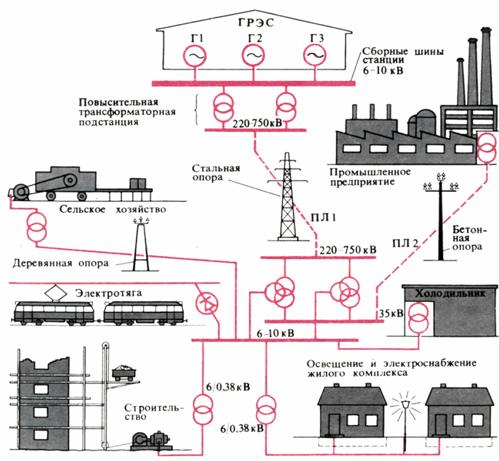
CHP (CHP) in addition to electrical energy, they generate heat, which is used to heat buildings and structures. The thermal energy supplied by the thermal power plant is distributed to consumers through heat networks.
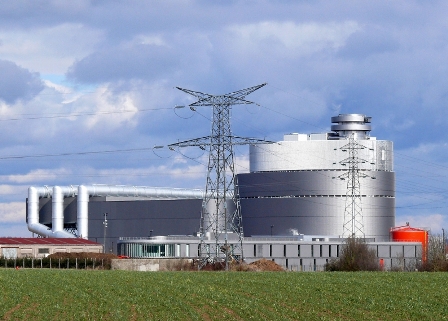
Characteristics of the power system
When considering the operation of the power system, special attention must be paid to the processes of transmission of electrical power. The generation and transmission of electrical energy is a complex interrelated process.
In the electric power system, the generation, transmission and consumption of energy by consumers takes place continuously, in real time. Accumulation of electricity (accumulation) in the volumes of the electricity system does not take place, therefore the balance between generated and consumed electricity is constantly monitored in the electricity system.
The peculiarity of electric power systems is the almost instantaneous transfer of electrical energy from sources to consumers and the impossibility of accumulating it in significant quantities. These properties determine the simultaneity of the process of production and consumption of electricity.
In the production and consumption of alternating current electrical energy, the equality of generated and consumed electricity at any instant of time corresponds to the equality of generated and consumed active and reactive power.
Therefore, at any moment of time in the stationary mode of the power system, the power plants must generate power equal to the power of consumers and cover the energy losses in the power transmission network, i.e. the balance of generated and consumed power must be observed.
The concept of reactive power balance is related to influence reactive power, transmitted through the elements of the electrical network, to the voltage mode. Disruption of the reactive power balance leads to a change in the voltage level in the network.
Typically, power systems that are deficient in active power are also deficient in reactive power. However, it is more efficient not to transfer the missing reactive power from neighboring power systems, but to generate it in compensating devices installed in this power system.
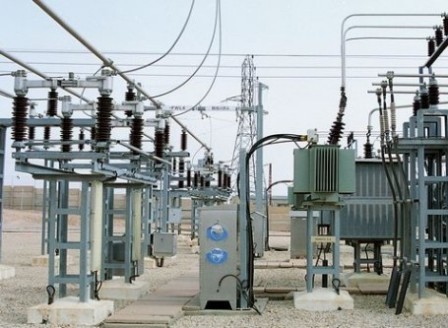 One of the main indicators of the presence of the balance between the produced and consumed electrical energy is network frequency… The frequency of the electric grid in Russia, Belarus, Ukraine and in most European countries is 50 Hz.If the frequency of the country's power system is within 50 Hz (tolerances ± 0.2 Hz), it means that the energy balance is observed.
One of the main indicators of the presence of the balance between the produced and consumed electrical energy is network frequency… The frequency of the electric grid in Russia, Belarus, Ukraine and in most European countries is 50 Hz.If the frequency of the country's power system is within 50 Hz (tolerances ± 0.2 Hz), it means that the energy balance is observed.
In the event of a deficit in the generated electricity, in particular its active ingredient, a power deficit occurs, that is, the energy balance is disturbed. In this case, there is a decrease in the frequency of the electrical network below the permissible value. The greater the deficit of electricity in the power system, the lower the frequency.
The process of breaking the energy balance is the most dangerous for the energy system, and if it is not stopped at the initial stage, then the complete collapse of the energy system will occur.
In order to prevent the collapse of the power system in the absence of power in the distribution substations, emergency automation is used — automatic frequency unloading (AChR) and automation of asynchronous mode elimination (ALAR).
AChR automatically turns off a certain part of the load of consumers, which reduces the energy deficit in the power system. ALAR is a sophisticated automatic system that automatically detects and removes asynchronous modes in electrical networks. In case of power shortage in the power system, ALAR works together with AFC.
In all sections of the power system, various emergency situations are possible: damage to various equipment at stations and substations, damage to cable and overhead power lines, disruption of the normal operation of relay protection and automation devices, etc. users in accordance with their power reliability category.
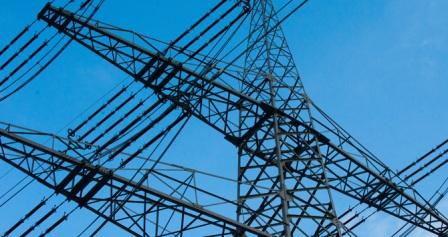
Voltage regulation characteristics
The voltage in the power system is regulated in such a way as to ensure normal voltage values in all areas. End-user voltage regulation is done according to average voltage values obtained from larger substations.
As a rule, such adjustment is carried out once, then the voltage is adjusted at large nodes - regional substations, since it is impractical to constantly adjust the voltage of each consumer substation due to their large number.
Voltage regulation in substations is carried out with the help of off-circuit tap changers and load switches built into power transformers and autotransformers. Regulation by means of off-circuit switches is carried out with the transformer disconnected from the mains (switching without excitation). On-load switching devices allow regulation of the load voltage, i.e. without the need to first disconnect the transformer (autotransformer).
Voltage regulation using the on-load switch of power transformers can be carried out both automatically and manually. Also, depending on the technical condition of the transformers (autotransformers), in order to extend the service life of the on-load switches, it can be a decision is made to regulate the voltage exclusively in manual mode, with preliminary load removal from the transformer.At the same time, the ability to switch the taps of the on-load tap-changer is preserved, and in the event of a need for rapid voltage regulation, this operation can be performed without first removing the load from the transformer.
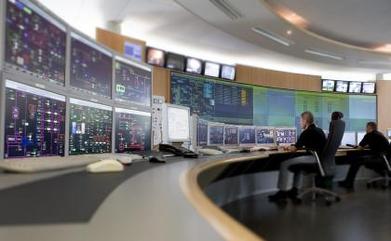
Losses of power and energy
The transmission of electrical energy is inevitably accompanied by power and energy losses in transformers and lines. These losses must be covered by a corresponding increase in power supply capacity, which leads to an increase in capital investment for the construction of the power system.
In addition, power and energy losses cause additional fuel consumption in power plants, the cost of electricity, thereby increasing the cost of electricity. Therefore, in the design it is necessary to strive to reduce these losses in all elements of the power transmission network.
See also: Power and energy loss in electrical circuits and Measures to reduce losses in electrical networks
Parallel operation of power systems
The electricity systems of countries or separate sections of the electricity system within a country can be connected to each other and as a whole constitute an interconnected electricity system.
If two energy systems have the same parameters, they can work in parallel (synchronously). The possibility of synchronous operation of two power systems makes it possible to significantly increase their reliability, because in the event of a large power deficit in one of the power systems, this deficit can be covered by another power system.By connecting the electricity systems of several countries, it is possible to export or import electricity between these countries.
But if two power systems have some differences in electrical parameters, in particular the frequency of the power grid, then if it is necessary to combine these power systems, their direct connection with parallel operation is unacceptable.
In this case, they get out of the situation by using direct current lines to transfer electricity between power systems, which makes it possible to combine unsynchronized power systems characterized by different grid frequencies.
